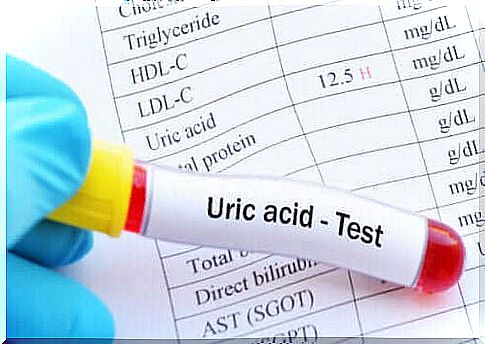What Are The Consequences Of High Uric Acid Levels?

Today we are going to talk about the consequences of high uric acid levels. A high uric acid level is referred to in medical terms as hyperuricemia. It happens when the body produces the uric acid after metabolizing molecules called purines. We get purines through food such as meat, anchovies or liver.
High uric acid levels are a condition that affects a large part of the population. People often associate it directly with gout, a syndrome characterized by inflammation in the joints. However, hyperuricemia can cause many other health problems.
The incidence of this situation is increasing because we are currently not eating as healthy as we should. Although a large genetic influence has been shown, specialists know that food plays a large role in this problem.
In this article, we’ll explain everything you need to know about having high uric acid levels. It is important to know the possible consequences to be aware of our choices and take more care of our lifestyle.
What are the causes of high uric acid levels?

As we have already mentioned, having high uric acid levels is often related to diet. Having an unbalanced diet, very rich in red meat, seafood and fish, causes its concentration to rise. Specialists also link a high intake of alcohol to this health problem.
However, these are not the only factors influencing. According to recent studies (Spanish link) , men are more at risk of suffering from this condition than women. Interestingly, prolonged intense physical activity can also cause your uric acid to rise.
Similarly, there are certain health conditions that doctors associate it with, such as diabetes or kidney disease. Being treated with chemotherapy for a cancer can also cause this problem.
What are the consequences of high uric acid levels?
Most people have heard of uric acid because of gout. Many people simply associate this health problem with pain in their big toe. However, people are completely unaware of all the consequences that high uric acid levels can have.
It is important to know that doctors associate this substance with an increased risk of cardiovascular disease. A high uric acid level causes a decrease in nitric oxide (Spanish link). It is an essential factor for our blood vessels to dilate and for proper blood flow.
When nitric oxide decreases, the arteries stiffen and it is easier to develop a vascular problem. For example, the risk of hypertension and arteriosclerosis increases.
The truth is that most patients who suffer from this condition have no symptoms. This complicates the situation further because the patient only notices the problem when there is already damage to the blood vessels or organs such as the kidneys.
kidney disease
The kidneys filter uric acid from the blood and excrete it through the urine. What happens is that when the concentrations are very high, kidney stones can form. These stones can cause pain and damage to the organ.
Gout and high uric acid

Gout is a syndrome that occurs because uric acid crystals are deposited in the joints and damage them. Joint pain is the most common symptom. It usually affects the big toe. In addition to pain , the joint may swell and be red. As gout progresses, the joint loses mobility. Many people experience persistent discomfort.
How do doctors diagnose it?
Usually, hyperuricemia causes no symptoms. In fact, specialists estimate that nearly 7% of men have it. However, doctors can check uric acid levels with a simple blood test. Even if there are no symptoms yet, you can take preventive measures to avoid complications. For example, improve your diet.
If the patient has felt any kind of manifestation in the joints, then doctors usually extract synovial fluid from the joints for analysis. They also use X-rays, ultrasound, and other techniques to confirm the diagnosis.








